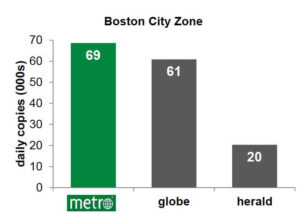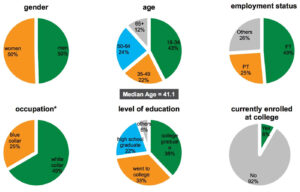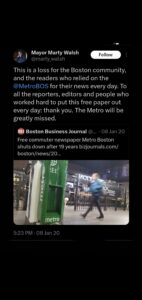
About The Boston Metro
The Boston Metro was founded in 2001 by Russel Pergament, the former publisher of the TAB newspaper chain that launched The Boston Metro. With an office in Downtown Crossing, the Boston Metro grew quickly as the free paper distributed at “T” stations throughout Boston.
But it’s important to understand the history of newspapers before Metro subway papers were created. The decline of USA newspaper circulation had been virtually unstoppable since the 1960s. Vibrant competition among dailies which once characterized virtually every major metropolitan area ceased to exist in all but a handful of major markets. Afternoon papers disappeared one by one.
Most troubling from an newspaper industry perspective was the near disappearance of young readers confirming there was nothing positive awaiting these titles in the future . In Europe companies like Norwegian media operation “Schibsted” and Sweden’s “Metro Publishing” found growing success with their dozens of free ‘commuter dailies,’ which were quick read tabloids distributed for free along public transit facilities.
Young adults on the way to work grabbed these free diversions on the morning commute and the new readers, generally unreachable through conventional bulky broadsheets, were immediately responsive to the advertisers who targeted them with appropriate goods and services. Equally significant, the papers had no evident editorial or political bias which readers appreciated.
Metro Publishing in Sweden wanted to create the first subway paper in the United States fashioned after their European model. For that purpose, Metro Publishing Sweeden launched the “Philadelphia Metro.” But the Philly Metro was off to a slow start tethered to the area’s SEPTA transit system with its preponderance of lower income residents. It didn’t have the massive student population concentration of other cities causing this new free daily in Philadelphia to struggle. Then Swedish management received an unsolicited business plan from Babson MBA Christopher Barnes who insisted the income levels in Greater Boston and its concentration of colleges with roughly 250,000 students near the mass transit stops created a much more favorable environment.
Metro Sweeden retained Christopher Barnes in a consulting capacity and hired Jim Kerasiotes, known primarily as a state transportation expert but with an extensive HR background, to find the proposed new daily’s top management. Kerasiotes asked Russel Pergament whose background in dailies and weeklies in Boston, as a startup publisher and sales manager over the years, suggested he could find the talent.
Pergament found the finance, design, and editorial talent but, unsatisfied with the Publisher candidates, told Metro Sweden he would be the Publisher himself. He defied Sweden’s instructions to keep the paper’s name as simply “Metro” and reflagged it “Boston Metro” to create immediacy and benefit from the prestige and credibility of the host city’s name. When Pergament hired some well known film critics Sweden told him not to have film reviews, deeming them ‘arbitrary.’ Pergament countered they weren’t arbitrary but were merely ‘capricious. ‘ Before the Swedish brass could object he was running tens of thousands of dollars in movie advertising and the owners backed off. In fact the company started syndicating Boston Metro’s film reviews in their Philly paper. and even had them translated for some European editions.
When the Boston Metro launched Boston’s two established dailies, the Boston Globe and the Boston Herald, used their extensive political influence to have metro’s news boxes removed from many transit stops and trucked to some unknown MBTA graveyard for old pipes, broken tracks and other junk. Pergament immediately called a news conference and made preparations for a federal lawsuit. The MBTA buckled and the hapless boxes were restored to the stations. Metro wanted to publicize the specifics of the traditional dailies abusive behavior but their Freedom Of Information (FOI) demands to the MBTA were ignored by the agency. Boston Metro dropped the matter and their attempt at the FOI request as they recognized they had been given some terrific publicity coincident with the launch.
The Boston Metro paper began an aggressive series of investigative reports on a wide array of public safety and finance matters. Even more appealing to readers were the data dives, ie, delving into obscure but compelling information that no other media shared with readers. Among the most popular were the Health Code Violations cited by Inspectors at area restaurants, names of doctors sanctioned by the state medical board, names of attorneys disbarred or otherwise punished by the states Board of Bar Overseers, stockbrokers charged with client abuse by various state and federal regulatory agencies. In addition, lots of ink devoted to public salaries and pensions. This information was highly popular.
The Boston Metro had surprisingly landed advertising contracts with the likes of Filene’s, Bloomingdale’s, Jordan Marsh, Lord & Taylor, prestige clients who had never before spent money in a free daily and began delivering steady profits. The Boston Metro then approached the Boston Globe suggesting they jointly fashion a combination ad-buy for recruitment advertising, a category the Globe dominated in the pre-internet days. Globe ad rates were astronomical and their readers were way beyond middle aged. So this combo deal meant recruiters could reach a much younger audience overall at far lower CPM’s (cost per thousand) and get better results for less cost. This worked out well and ultimately the Boston Globe decided to buy approximately 50 percent of the Boston Metro until 2013.
Metro Sweeden’s New York office, which had largely stayed out of the way during the new paper’s ascent, decided to get involved. They began issuing a series of demands which the Boston team deemed destructive of the paper’s health and growth and which, consequently, were ignored. Pelle Tornberg, Metro’s brilliant, charismatic leader in Sweden, sided with the operating team who who were delivering good results and the episode faded away.
Boston metro’s rapid success, commitment to local and investigative reporting, and readiness to unshackle itself from the “European content model,” caused the Boston Metro to become a beacon for similar free commuter dailies in DC, Chicago and elsewhere.
By 2016, The Metro was Boston’s third highest newspaper in circulation behind the #1 Boston Globe and #2 Boston Herald. By February of 2018, The Boston Metro was the highest circulation daily newspaper in Boston with 68,689 daily copies distributed within the Boston city zone.
The Boston Metro daily print circulation (Mon-Thu) was up 17% year-over-year to 68,689 daily copies, 55% more print copies distributed than the Herald on weekdays (44,109)! On Thursdays, “Metro WEEKEND” had a print circulation of 80,410 vs. 64,000 copies Monday – Wednesday.
The Boston Metro had 800+ distribution points that included hand promoters and street boxes. The Boston Metro had an exclusive deal to be distributed within the MBTA; 125 racks were installed in stations throughout the Boston transit system allowing riders to pick up the paper anytime of the day.

Every week, The Boston Metro reached 1 in 4 adults living or working in Suffolk county – a targeted audience of young, active professionals.
Boston Metro readers facts:
- Every day, The Boston Metro reached more people than the Improper Bostonian in a week.
- Every day, The Boston Metro reached more people residing or working in Suffolk county than any other daily newspaper.
- The Boston Metro readers were 17 years younger than the readers of the Globe or the Herald.
- 71% of Metro readers were aged 21-54 compared to only 43% of the Herald readers.
- 87% of The Boston Metro readers didn’t read the Herald.

Founder Russel Pergament said, “…the one attribute they [The Boston Metro] had was an ability to connect with young workers during the daily commute.”
The 2020 data showed that the paper was down to a daily circulation of 50,000 for its Monday-through-Thursday editions the last year it was printed.
Mayor Marty Walsh called the closure “a loss for the Boston community, particularly for the readers who still relied on Metro Boston for daily news coverage. To all the reporters, editors and people who worked hard to put this free paper out every day: thank you,” Walsh tweeted Wednesday. “The Metro will be greatly missed.”

The Boston Metro announced that it was closing its print edition in January of 2020. The Boston Mayor at that time, Marty Walsh, called the closure “A loss for the Boston community, particularly for the readers who still relied on Metro Boston for daily news coverage. To all the reporters, editors and people who worked hard to put this free paper out every day: thank you,” Walsh tweeted Wednesday, January 8th, ’20, Metro will be greatly missed.”
Fortunately, The Boston Metro continues today as a Newsportal and is still local and independent. Please email us if you’d like to volunteer or intern for today’s Boston Metro: News@FreeNewsWire.com
Written by Bryant Jones from newspaper articles and documents about the Boston Metro and Russel Pergament:
https://www.bostonglobe.com/2020/01/08/metro/free-metro-boston-paper-is-shutting-down-after-19-years/